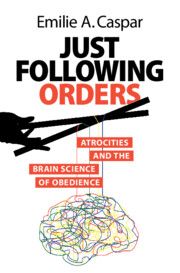42 results
‘Everybody’s doing it’: on the persistence of bad social norms
-
- Journal:
- Experimental Economics / Volume 23 / Issue 2 / June 2020
- Published online by Cambridge University Press:
- 14 March 2025, pp. 392-420
-
- Article
- Export citation
Experimental departures from self-interest when competing partnerships share output
-
- Journal:
- Experimental Economics / Volume 18 / Issue 1 / March 2015
- Published online by Cambridge University Press:
- 14 March 2025, pp. 89-115
-
- Article
- Export citation
What drives conditional cooperation in public good games?
-
- Journal:
- Experimental Economics / Volume 26 / Issue 2 / April 2023
- Published online by Cambridge University Press:
- 14 March 2025, pp. 435-467
-
- Article
-
- You have access
- Open access
- HTML
- Export citation
Liking what others “Like”: using Facebook to identify determinants of conformity
-
- Journal:
- Experimental Economics / Volume 21 / Issue 4 / December 2018
- Published online by Cambridge University Press:
- 14 March 2025, pp. 793-814
-
- Article
- Export citation
Does context matter more for hypothetical than for actual contributions? Evidence from a natural field experiment
-
- Journal:
- Experimental Economics / Volume 11 / Issue 3 / September 2008
- Published online by Cambridge University Press:
- 14 March 2025, pp. 299-314
-
- Article
- Export citation
Introduction
-
- Book:
- Protestant Bodies
- Published online:
- 20 February 2025
- Print publication:
- 27 February 2025, pp 1-37
-
- Chapter
- Export citation
Conformity in the lab
-
- Journal:
- Journal of the Economic Science Association / Volume 1 / Issue 1 / July 2015
- Published online by Cambridge University Press:
- 17 January 2025, pp. 15-28
-
- Article
- Export citation
16 - The Segregation of Belief: How Structure Facilitates False Consensus
- from Part IV - Society
-
- Book:
- Behavioral Network Science
- Published online:
- 08 November 2024
- Print publication:
- 19 December 2024, pp 258-277
-
- Chapter
- Export citation
4 - Norms, Group Pressures, and Deviancy
- from Part II - How Groups Function
-
- Book:
- Groups
- Published online:
- 12 December 2024
- Print publication:
- 05 December 2024, pp 71-92
-
- Chapter
- Export citation
Chapter 2 - Psychological Studies
-
- Book:
- Cultural Stereotype and Its Hazards
- Published online:
- 21 November 2024
- Print publication:
- 28 November 2024, pp 17-50
-
- Chapter
- Export citation

Just Following Orders
- Atrocities and the Brain Science of Obedience
-
- Published online:
- 25 July 2024
- Print publication:
- 25 July 2024
5 - Pierre Bayle and Tormented Conscience
-
- Book:
- The Coerced Conscience
- Published online:
- 07 December 2023
- Print publication:
- 21 December 2023, pp 91-107
-
- Chapter
- Export citation
4 - Baruch Spinoza and Conscientious Speech
-
- Book:
- The Coerced Conscience
- Published online:
- 07 December 2023
- Print publication:
- 21 December 2023, pp 69-90
-
- Chapter
- Export citation
1 - A New Kind of Politics?
-
- Book:
- The Coerced Conscience
- Published online:
- 07 December 2023
- Print publication:
- 21 December 2023, pp 1-21
-
- Chapter
- Export citation
Chapter 24 - Of Moderate Puritans and Popular Prelates
- from Part III - Laudianism: What It Wasn’t
-
- Book:
- On Laudianism
- Published online:
- 05 October 2023
- Print publication:
- 19 October 2023, pp 317-336
-
- Chapter
- Export citation
Chapter 34 - Of Converts, Collaborators and Apostates
- from Part V - Laudianism as Coalition: The Constituent Parts
-
- Book:
- On Laudianism
- Published online:
- 05 October 2023
- Print publication:
- 19 October 2023, pp 444-475
-
- Chapter
- Export citation
Chapter 25 - The Puritan Threat, the Church of England and the Personal Rule as a Period of Reformation
- from Part III - Laudianism: What It Wasn’t
-
- Book:
- On Laudianism
- Published online:
- 05 October 2023
- Print publication:
- 19 October 2023, pp 337-350
-
- Chapter
- Export citation
Dogmatism and Domination: A Simulation Study
-
- Article
-
- You have access
- Open access
- HTML
- Export citation
Chapter 9 - War as Transformative
- from Part II - Change Agents, in Theory and Practice
-
- Book:
- Political Plasticity
- Published online:
- 15 January 2023
- Print publication:
- 05 January 2023, pp 101-114
-
- Chapter
- Export citation
Reaching an Optimally Distinctive CSR Strategy: Examining the Antecedents of CSR Scope Conformity and Emphasis Differentiation Among Chinese Publicly Listed Companies
-
- Journal:
- Management and Organization Review / Volume 19 / Issue 1 / February 2023
- Published online by Cambridge University Press:
- 23 September 2022, pp. 32-63
-
- Article
- Export citation







